
views
Basic Drain Cleaning with Vinegar and Baking Soda

Pour a pot of near boiling water down your drain. Fill a small pot with water and heat it up on your stove until it’s almost boiling. Then, just slowly pour the hot water down your drain to rinse out any loose debris or residue that’s causing the smell. If you don’t have the time to boil water, just run the hottest water from your tap down the drain for a few minutes to help loosen up smelly residue. Sometimes, hot water may be enough to break apart gunk that makes your drains smelly.

Sprinkle ½ cup (114 g) of baking soda down the drain. Remove the cover or stopper from your drain if it has one. Pour the baking soda out slowly, and try to get as much of it as you can down the drain. The baking soda will cling to the gunk inside your drain to start neutralizing odors. Kadi Dalude, a professional home cleaner, mentions that baking soda deodorizes your drain, but it also works great for clearing minor clogs. You can clean any stinky drain with vinegar and baking soda, so it’s perfect and safe for your kitchen sink, bathroom sink, or shower.
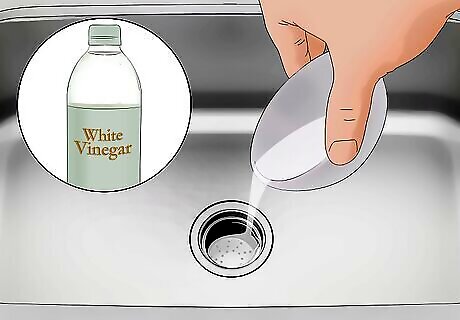
Pour ⁄2 cup (120 mL) of white vinegar down the drain. Slowly pour distilled white vinegar down your drain so it starts to bubble and fizz with the baking soda. Cover the drain with its stopper or place a towel over it to force the bubbles further down the pipe. The fizzing mixture will continue breaking apart debris and deodorize smelly drains even more. If you want even more cleaning power, heat the vinegar on the stove until it’s just about boiling. The extra heat will loosen up stubborn residue so it rinses out easily.

Wait at least 10 minutes for the cleaner to take effect. Give the baking soda and vinegar time to sit in the drain pipe so it can break up as much smelly debris and buildup as possible. Keep the drain covered for the entire time to prevent the smell or cleaner from coming back up. If it’s been a while since you’ve cleaned your drain, leave the baking soda mixture in the drain overnight.
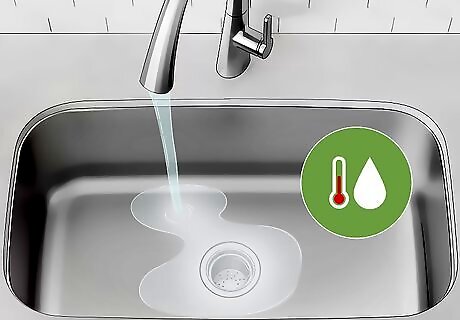
Flush your drain with more hot water. Heat another pot of water on your stove or turn your faucet to the hottest setting. Let the water wash away any residual cleaner and gunk inside of the drain so it has a fresh scent. If you still notice odors, try running baking soda and vinegar down your drain again. If the smell persists, you may need to do a more thorough cleaning.
Cleaning a Stinky P-Trap

Clean out a sink drain trap if your drain is still clogged or smelly. A P-trap is a curved pipe connecting the drain to the pipes in your wall that prevents sewage gasses from entering your home. When a P-trap is dirty or dried out, you may still notice odors coming from your drain. P-traps are typically right underneath a bathroom or kitchen sink, so they’re easy to access and clean on your own. P-traps for floor drains in tubs and showers are typically inaccessible inside your walls or under your floor. Try running an auger through your drain instead.

Unscrew the P-trap from your sink’s drain. Locate the curved pipe directly underneath your drain and place a bucket underneath it. Find the 2 plastic or metal nuts on either end of the P-trap, and turn them counterclockwise with a wrench. Once it’s loose enough, slowly pull the P-trap off and empty any water inside of it into the bucket. Make sure you don’t use your sink after disconnecting the P-trap. For added safety, turn off the sink’s water supply by twisting the valves on the wall clockwise.
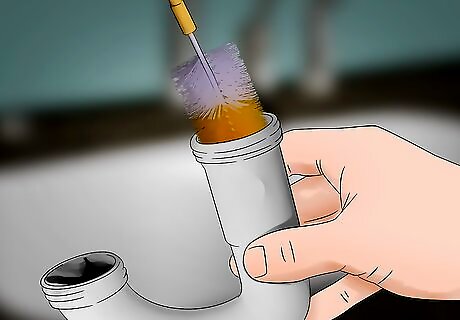
Scrub the P-trap with a nylon bottle brush and a paper towel. To clean your sink trap, push the brush through the pipe to clear out any clogs or grime causing the stinky drain. After using the brush, push a paper towel through the P-trap to pick up any grime still left inside. If you don’t have a bottle brush, try straightening a wire hanger and using it to scrape out debris. Alternatively, take your P-trap outside and flush out the debris using a garden hose. Check the pipes connecting to your drain and wall for any smelly debris as well. If you notice any, wipe it out with a paper towel.
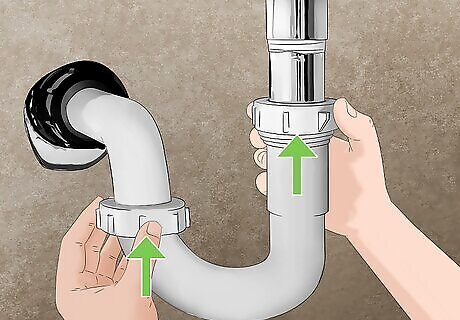
Reassemble your P-trap and check for leaks. Once your P-trap looks clean, line it back up with the pipes under your sink and tighten the nuts. Keep the bucket under the pipe and run hot water down your drain for about 15 seconds. Check the pipe connections, and tighten them if any water leaks out. After cleaning your P-trap, try pouring hot water down your drain or using baking soda and vinegar to neutralize any other residual odors. If you still notice unpleasant odors in your drain or if a clog forms, then you may need to use an auger to reach further down in your pipes.
Removing Smelly Clogs with an Auger

Use a drain auger if you suspect a clog deeper in your pipes. A drain auger is a long piece of metal that fits down your drain pipe and catches onto any clogs. If using baking soda and vinegar or cleaning your P-trap doesn’t work, then an auger may be able to reach the smelly residue. Drain augers work well for removing clogs and smelly residue from any type of drain in your home.
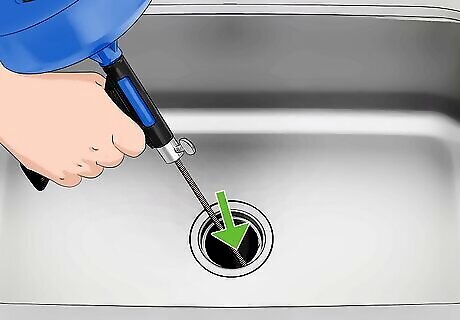
Feed the end of the auger down the drain. Pull out the end of the auger and place it inside of the drain. Slowly push the auger down the drain line so it works around the curves in your pipes. Then, start cranking the auger’s handle until it doesn’t extend any further. Avoid using a drain auger if you recently used any chemical cleaners because they could come back up the drain. Wear rubber gloves and safety glasses to protect yourself from splashes. If you need to reach further down a sink drain, remove the curved P-trap underneath the basin. Then, feed the auger into the pipe connected to your wall.

Twist the auger to break apart and pull out blockages. Once the auger doesn’t move forward any more, twist the handle to rotate the auger head. The debris will either break apart and move out from your drain pipe, or it will catch on the auger head. Pull the auger back out from your drain to remove the clog. Wipe the smelly residue off of the auger head with a paper towel as you pull it out from your drain.

Flush the drain with hot water to clear out the rest of the clog. Turn on the hottest water from your tap, and let it flow into the drain for several minutes. If the water flows freely down the drain and you don’t notice any odors, then you successfully removed the clog. If you still notice an odor or clog, try running the auger through your drain again to see if there’s any debris. According to cleaning guru Bridgett Price, you may need to run the auger through your drain 4 or 5 times to completely remove a large clog. If you can’t reach anything else with your auger, then it may be time to hire a professional plumber to find the source of the problem.
Deodorizing a Smelly Garbage Disposal
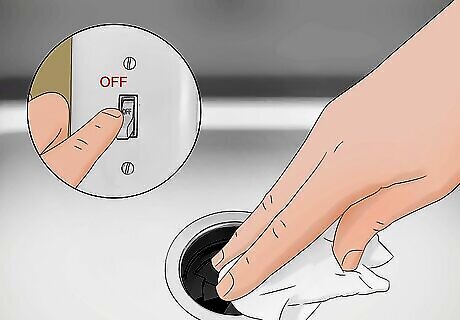
Wipe the rubber guard with a damp cloth. Unplug your garbage disposal and disconnect it from power before you start working. Wet a microfiber cloth with warm water and clean your garbage disposal by wiping the rubber piece around the opening. Try to remove as much smelly gunk from the rubber as you can. Avoid reaching into your garbage disposal while it still has power because you could get seriously injured if it turns on.

Flush your disposal with baking soda, vinegar, and boiling water. Pour ½ cup (114 g) of baking soda straight into your garbage disposal. Immediately pour in 1 cup (240 mL) of distilled white vinegar to make the solution fizz. Let the bubbles die down before pouring a full pot of boiling water into the drain. Let the solution sit for about 5 minutes before turning on cold water and running the disposal for a few seconds. The baking soda and vinegar loosens up buildup inside your garbage disposal and on the blades, and they also naturally deodorize smelly drains.

Try running ice cubes through your disposal to clean out residue. Put a couple ice cubes down the drain, run cold water from the faucet, and turn on your garbage disposal. As the disposal grinds the ice, it will remove any stinky buildup from the blades and interior. For added scrubbing power, put about 1 cup (273 g) of rock salt down your drain with the ice cubes. Salt acts as an abrasive and may help remove stubborn residue that’s causing smells.

Grind citrus peels to add a fresh scent. Remove the peel from a lemon, lime, or orange and put it down the drain with your garbage disposal. Run cold water from your faucet and turn on your disposal to break apart the citrus peels. The peels will remove bacteria buildup as well as leave a pleasant, fruity smell in your drain.
Causes of Stinky Drains

Bacteria or mold buildup Over time, any food residue, hair, soap scum and other organic materials stuck in your drain start to break down. As the gunk sits for longer, bacteria and mold forms and creates a rotten egg smell inside of your drain.

Dry P-trap The curved P-trap under a drain usually has water inside to seal off sewage odors that can waft up your pipes. If you haven’t used a sink, bath, or shower in a while, or if there are warm temperatures, the water may dry out and allow the smelly fumes to come out from your drain.

Clogged pipes If something gets inside of your pipes and completely obstructs them, it could trap smelly odors inside of your drain. These clogs may also grow and form bacteria as they sit longer in your drain, which can make the smell get even worse.

Blocked drain vent The drain air vent connects to your drain pipes and runs through your home’s roof to release any sewage fumes. If leaves or debris get caught anywhere inside of the vent, then the fumes can get trapped and come out from your drains instead. Cleaning out your drain vent requires you to access it from your roof, so it may be best to contact a professional plumber to clean it out.

Faulty plumbing If your plumbing fixtures are old, damaged, or installed improperly, then it’s possible for sewage gasses to leak out from your drains. It may mean that you just need to tighten seals around your drains, or it could be a sign to replace damaged components.
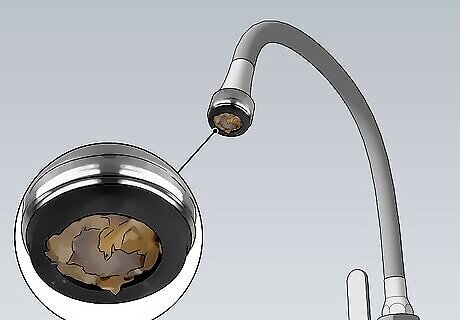
Dirty aerator If you notice that water smells before it goes down the drain, then there may be bacteria buildup inside the mesh aerator at the end of your faucet. To clean your aerator, unscrew it from your faucet and rinse out any debris. Then, soak it in distilled white vinegar and scrub it with an old toothbrush before reassembling it.
How often should you clean your drains?

Clean your drain whenever you notice a bad smell. As soon as you catch a whiff of bad odors coming from your drain, it’s a good indicator that it’s time to clean. It may take a few weeks or a few months for your drain to start smelling, so just set aside some time once it starts smelling.
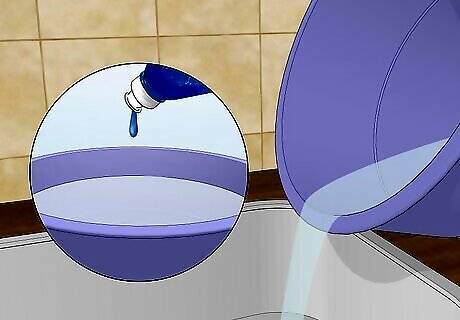
Flush your drains weekly to keep odors away. Warm up a pot of water on the stove and let it heat up until it’s just about boiling. Add a few squirts of dish soap and pour the water down your drain to rinse out buildup and prevent your drains from smelling.
Preventing Smelly Drains

Run water down drains to refill the P-traps. If you notice sewage smells coming from your drain, turn on your faucet and let the water run for about 15 seconds. That way, the water can refill the drain’s trap and prevent the smells from getting inside your home.
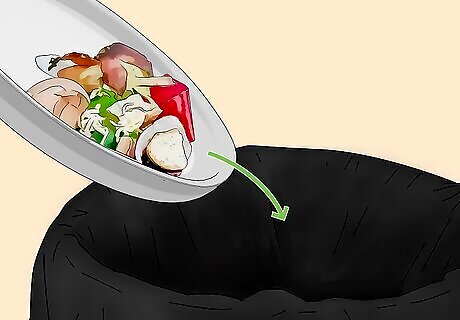
Toss food scraps in the garbage instead of in the sink. Rather than putting all of your leftover food down the drain, scrape as much as you can into the trash. Keep a strainer over your drain as you rinse off dishes to catch any other large pieces of food residue. That way, it’s less likely to form smelly mold or bacteria deep inside your drain or garbage disposal. Sticky foods like rice and pasta can get caught more easily inside your drain, so always put them in your trash. Avoid rinsing oils or grease down your drain because they could solidify and create clogs.

Keep your garbage disposal running after it finishes grinding. Once it sounds like you’ve ground up all the food in your disposal, let it run for about 5 more seconds. That way, it continues to flush out any residue or grime stuck inside.




















Comments
0 comment